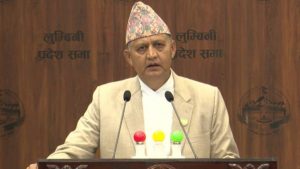
Concerns Mount as Nepal’s Public Debt Soars

In a concerning financial development, the Government of Nepal has witnessed a staggering surge in public debt liability, amounting to Rs 1.3 trillion over the span of five and a half years. The situation reflects the challenges faced by the government in managing its finances and meeting revenue targets.
As of the fiscal year 2018/19, the combined internal and external debt stood at Rs 1.04 trillion. However, the trajectory has seen an alarming increase, surpassing Rs 1.3 trillion within the mentioned timeframe. By mid-December of the ongoing fiscal year 2023/24, the total public debt liability has reached a daunting Rs 2.3 trillion.
The surge in public debt is attributed to the government’s struggle to meet revenue collection targets, leading to a rapid increase in the reliance on internal and external loans over the past five years. Economists, including Dilli Raj Khanal, have noted a significant uptick in the government’s propensity to incur public debt over the last decade.
“During the last decade, the tendency of the government to take public loans is increasing,” remarked economist Dilli Raj Khanal. He highlighted that despite the ongoing trend, there is a growing concern as the government appears to be resorting to public loans to cover recurrent expenses.
According to the Public Debt Management Office (PDMO), the public debt was Rs 1.04 trillion in FY 2018/19, and within a year, it escalated to Rs 1.4 trillion in FY 2019/20, marking an increase of over Rs 300 billion. Subsequent years witnessed further spikes, reaching Rs 1.7 trillion in 2020/21 and surpassing Rs 2.2 trillion in 2022/23. By the end of the first five months of the current fiscal year, the public debt has reached an alarming Rs 2.3 trillion.
Breaking down the current debt, internal debt liability stands at Rs 1.197 trillion, while external debt liability is at Rs 1.173 trillion. This financial burden calls for a closer examination of the government’s fiscal policies and the need for effective strategies to address the growing public debt crisis.
- Government Committed to Boosting Economy Through Private Sector Cooperation: Minister Bhandari
- National Information Commission Submits Annual Report to PM Oli
- Varun Beverages Nepal Recognized for Highest Contribution to Social Security Fund
- Health Minister Stresses Efficient Resource Utilization at National Review Meeting












Comments